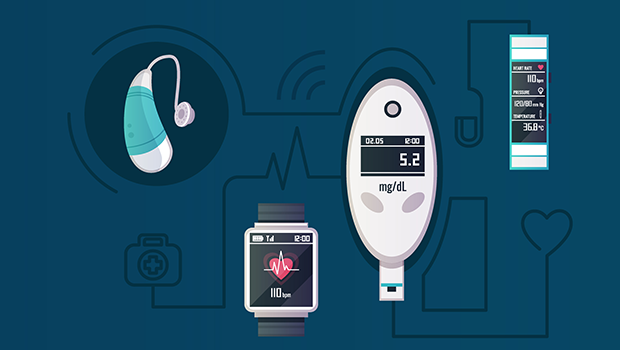
From paper to bytes, from doctor-driven to patient-centric. What’s next?
Benedict Tan, Group Chief Digital Strategy Officer of SingHealth, once got an alert from his watch tracker that his heartrate was unusually fast, prompting him to take a few deep breaths. Like him, many consumers are now using smart devices to keep tab on their personal fitness levels and even vital signs.
In Benedict’s vision for the future of healthcare, technology will be harnessed to do even more for patients and clinicians. “Imagine if your tracker is connected to your healthcare provider. When it detects serious trouble, it urges you to go to the A&E immediately, where your doctor is already expecting you!”
What’s more, doctors would have already seen patients’ health data, sent by the smart devices and called up patients’ medical records in the hospital, saving precious time and lives.
From digitisation to digitalisation
“Healthcare functions on data and data is so much more useful when it is digital,” said Benedict. Without digital information, it is impossible for the above scenario to play out.
Recording clinical notes, diagnostic tests results and vital signs in electronic format means doctors and researchers can access them easily. As technology advances and patients relying more on smart trackers, the volume of data generated will increase exponentially.
With access to more and frequent data, healthcare providers will have a more comprehensive profile of patients, allowing better diagnosis and timely interventions.
For example, continuous glucose monitoring devices can show up abnormalities such as spikes in blood sugar levels in patients with diabetes by monitoring them throughout the day. Episodic tests at the clinic every few months may not reveal such trends.
“Digitisation is the first step to digitalisation. With electronic data, we can apply different digital technologies to improve our business model and processes, and ultimately improve patient care,” said Benedict. As technology advances, we will one day be able to convert an entire human health information to digital and digitalize the care and treatment process.
One technology that will play a big part in healthcare is Artificial Intelligence (AI). In preventive health, AI can monitor patients’ condition 24/7 and alert them or their caregivers when things go wrong. In the area of diagnostics, AI adds value by transforming data into actionable insights, and providing faster and more consistent results.
Take the case of Selena+, an AI software system that analyses retinal photographs to detect signs of diabetic retinopathy. It has reduced waiting time for test results from days to minutes and returns more consistent interpretations. With a deep learning system, its accuracy will also improve over time.
Similarly, digital technology such as Internet of Things, robotics, augmented reality and virtual reality are increasingly used to improve healthcare outcomes.
Patients expect digitalisation
Benedict points out that the push for digitalisation will also come from patients.
“Digitalisation has transformed many industries. Whether catching a movie, ordering food or transferring funds, consumers are getting used to digital convenience. When they walk into our clinics or hospitals as patients or caregivers, they will expect the same level of service they experienced elsewhere.”
Today, patients can use a suite of e-services to make a visit to the clinics more convenient. There’s Health Buddy to manage appointments, track queue numbers, order medicine or make payment. Pre-admission patients can count on Admissions Buddy for cost estimates or choose their ward types.
My Visit, a new app currently on trial, is set to transform future outpatient visits. The app, piloted at SGH Diabetes and Metabolism Centre, empowers patients as active partners in their own care with the ability to track care outcomes, access care instructions and customised educational materials, as well as manage appointments and order medicine delivery.
Another ground-up initiative is a bedside app called MyCare. Using a tablet, inpatients can view their daily care schedule, meals and medical information or request for housekeeping services or assistance. The app empowers patients in their own care and allows nurses to focus on their primary duties.
“Such initiatives are highly encouraged. It shows how we can use digitalisation to make things better for our patients as well as for our own staff,” he added.
4 strategies of digital transformation
To fully unlock the potential of digitalisation in healthcare, more needs to be done to prepare the organisation for a digital transformation. Benedict stresses the importance of four strategies coming together.
First, we must continue to digitise healthcare data and maintain its integrity and usefulness. This forms the bedrock of all digitalisation efforts.
Second, invest in mobile technology, such as mobile devices and apps. This empowers patients to self-serve and take greater ownership of their health matters. It also allows clinicians to access patients’ electronic medical data at point of care, anytime, conveniently. Staff can also easily access corporate applications (e.g. leave application, claims submissions and staff directory etc) and knowledge resources (journals, books)
Third, we need to re-architect our IT systems to support the opportunities afforded by digitalisation. One way is to use agile methodology for IT development, in which both the needs and solutions evolve in the process, driven by the project goal, and in close collaboration with the users of the solution. This allows us to be more responsive to changing demands and technology.
Fourth and most important of all, the organisation culture needs to embrace digital transformation as barriers to digitalisation are often non-technological.
“Change management is challenging but we can manage our fear of change. We need to build up the level of trust among staff to manage the changes, for example, by sharing more information about each other’s work areas,” he suggested.
“The focus is always on the patient. How does digitalisation improve patient care and service? How do we get there?”
The technology is ready. Are we?













 Get it on Google Play
Get it on Google Play